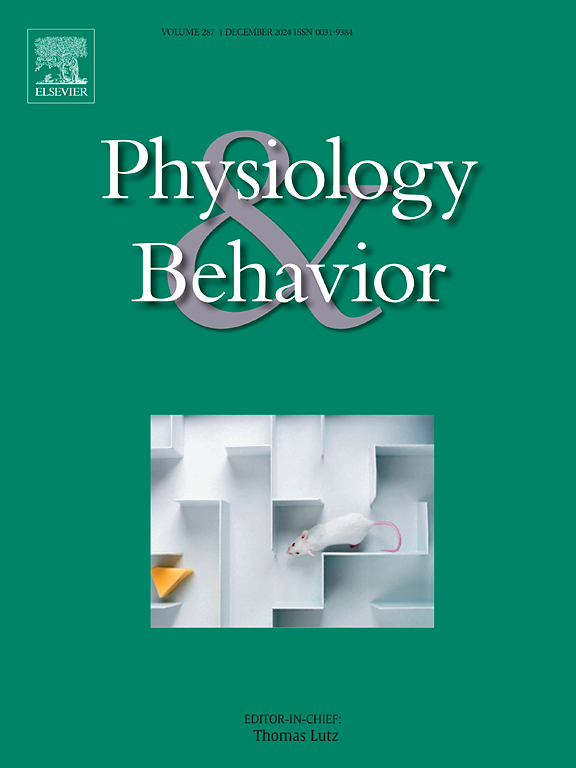利培酮和自主运动干预对幼年雌性大鼠海马和前额叶皮层突触可塑性基因表达的影响
IF 2.4
3区 医学
Q2 BEHAVIORAL SCIENCES
引用次数: 0
摘要
精神疾病和抗精神病药物与神经可塑性受损有关,而体育锻炼已被报道可以增强神经可塑性并改善认知和情感过程。因此,本研究假设自愿运动可以增强被利培酮(一种常用的儿科抗精神病药物)破坏的幼年大鼠的突触可塑性。方法32只雌性幼年大鼠随机分为载药组+久坐组,利培酮(0.9mg/kg;(b. d .)+久坐,车辆+运动(每天三小时使用跑步轮),利培酮+运动组,治疗四周。大脑被收集起来作进一步分析。结果利培酮和运动干预后,海马组织中Bdnf、Ntrk2、Grin2b mRNA表达均升高。运动上调Grin1和Grin2a的表达。利培酮治疗组Syn1和Syp mRNA表达增强。利培酮组Mfn1和Drp1 mRNA的表达均降低。在前额叶皮层,Bdnf和Dlg4的表达因运动而上调,而Ntrk2的表达因利培酮而降低,并因运动而逆转。利培酮在有或没有自主运动的情况下均能降低Mfn1 mRNA的表达。运动增强了利培酮降低的Ppargc1α基因表达。结论利培酮对雌性幼年大鼠突触可塑性的影响机制复杂:增强海马中某些关键基因,抑制线粒体功能必需基因。与我们的假设一致,在雌性幼年大鼠中,自愿运动促进了有利于突触可塑性的基因,并增强了利培酮减少的特定基因。本文章由计算机程序翻译,如有差异,请以英文原文为准。
The effects of risperidone and voluntary exercise intervention on synaptic plasticity gene expressions in the hippocampus and prefrontal cortex of juvenile female rats
Background
Psychiatric disorders and antipsychotics are associated with impaired neuroplasticity, while physical exercise has been reported to enhance neuroplasticity and improve cognitive and affective processes. Therefore, this study hypothesizes that voluntary exercise can enhance synaptic plasticity in juvenile rats disrupted by risperidone, a commonly prescribed antipsychotic for pediatric patients.
Methods
Thirty-two juvenile female rats were randomly assigned to Vehicle+Sedentary, Risperidone (0.9mg/kg; b.i.d)+Sedentary, Vehicle+Exercise (three hours daily access to running wheels), and Risperidone+Exercise groups for four week treatment. Brains were collected for further analysis.
Results
In the hippocampus, the mRNA expressions of Bdnf, Ntrk2, and Grin2b were increased by risperidone and exercise intervention. Exercise upregulated expression of Grin1 and Grin2a. Syn1 and Syp mRNA expression were enhanced by exercise in the risperidone-treated group. The expression of both Mfn1 and Drp1 mRNA were decreased by risperidone-only treatment. In the prefrontal cortex, Bdnf and Dlg4 expression was upregulated by exercise, while the Ntrk2 expression was reduced by risperidone and reversed by exercise. The Mfn1 mRNA expression was decreased by risperidone with or without voluntary exercise. The risperidone-decreased Ppargc1α gene expression was enhanced by exercise.
Conclusion
Risperidone affects synaptic plasticity through a complex mechanism in female juvenile rats: enhancing certain key genes in the hippocampus while inhibiting genes essential for mitochondrial function. In line with our hypothesis, voluntary exercise promotes genes beneficial for synaptic plasticity and enhances specific genes reduced by risperidone, in female juvenile rats.
求助全文
通过发布文献求助,成功后即可免费获取论文全文。
去求助
来源期刊

Physiology & Behavior
医学-行为科学
CiteScore
5.70
自引率
3.40%
发文量
274
审稿时长
47 days
期刊介绍:
Physiology & Behavior is aimed at the causal physiological mechanisms of behavior and its modulation by environmental factors. The journal invites original reports in the broad area of behavioral and cognitive neuroscience, in which at least one variable is physiological and the primary emphasis and theoretical context are behavioral. The range of subjects includes behavioral neuroendocrinology, psychoneuroimmunology, learning and memory, ingestion, social behavior, and studies related to the mechanisms of psychopathology. Contemporary reviews and theoretical articles are welcomed and the Editors invite such proposals from interested authors.
 求助内容:
求助内容: 应助结果提醒方式:
应助结果提醒方式:


